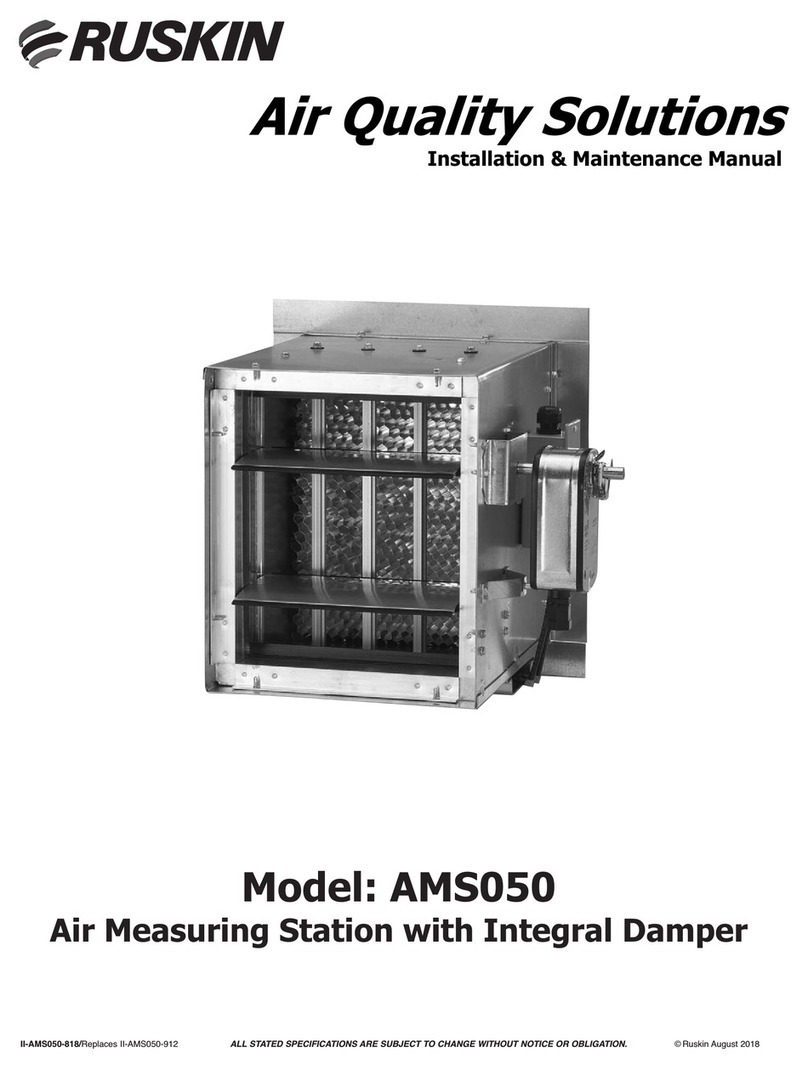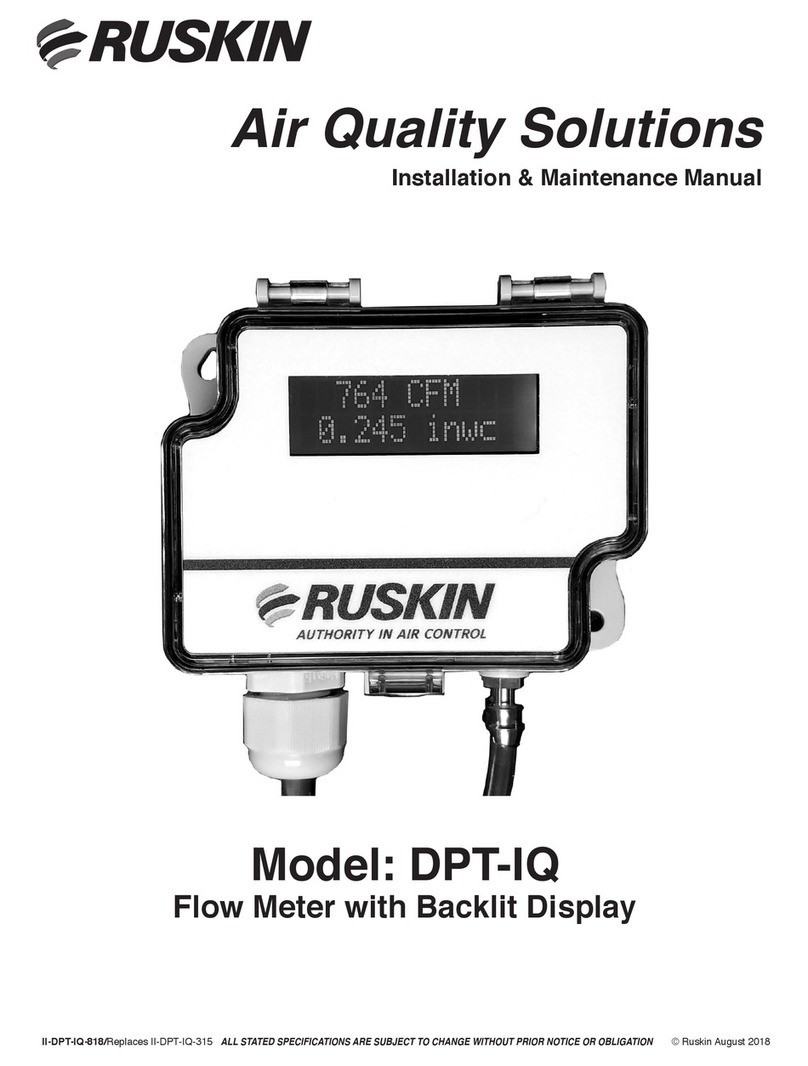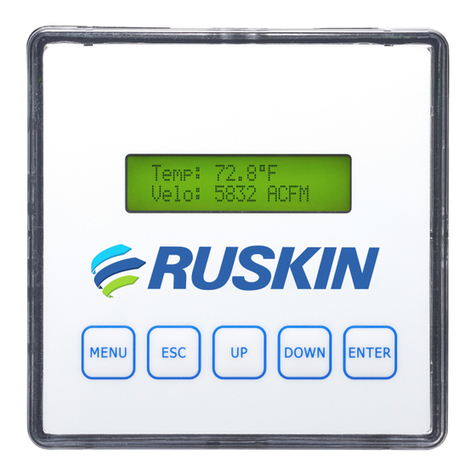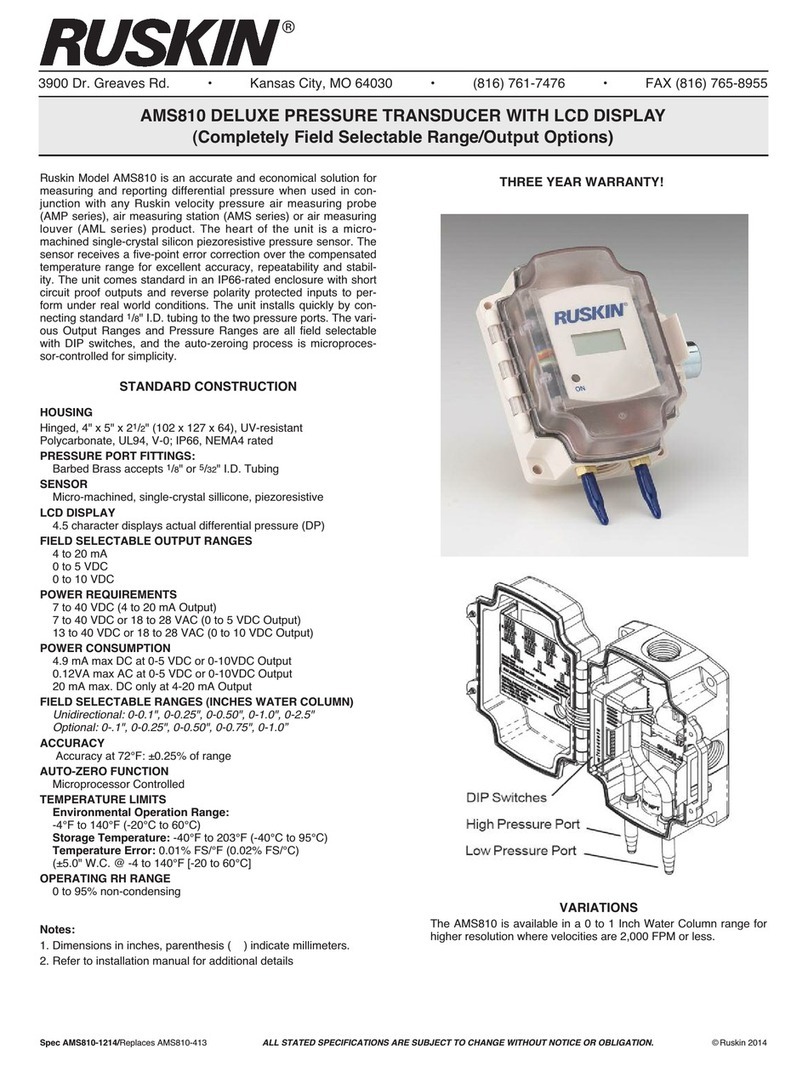
4
Airflow-IQ Start-up & Commissioning Guide
IMPORTANT: Only a qualified service technician should install this system. To avoid unsatisfactory operation
or damage to the product, strictly follow the instructions provided and do not substitute parts. Damage to the
product resulting from not following the instructions or using unauthorized parts may be excluded from the
manufacturer’s warranty coverage.
IMPORTANT: In addition to these instructions, the installation contractor shall comply with all local and
International codes and standards to ensure proper and safe installation.
Software Configuration Information for Commissioning:
After the installation described in this document is complete, please refer to the TDP05K Technical Bulletin for
information regarding configuration options.
The Technical Bulletin document can be viewed or downloaded at this location:
http://www.ruskin.com/catalog/servefile/id/6767.
The Technical Bulletin document can also be accessed via this QR Code:
Confirm power requirements before wiring actuator. Ruskin is not responsible for any damage to, or failure of
the unit caused by incorrect field wiring.
AD-1252 Thermal Dispersion Probe Airflow Measuring System Installation Instructions 1
preliminary - this information may change
Applications
The AD-1252 Thermal Dispersion Probe Airflow
Measuring System is an air-measurement device that
uses thermal dispersion technology to measure the
airflow velocity and temperature in duct and plenum
applications. Insertion probes are typically installed in
retrofit applications but may also be specified on new
construction projects.
The product may be used in rectangular, oval or round
applications when installed in accordance with this
installation manual. Use behind a rain hood, in front of
an outside air damper, return air duct, downstream of a
fan discharge or in the exhaust duct.
North American Emissions Compliance
United States
Canada
Installation
Mounting
The sensor density is based on extensive lab testing to
optimize the accuracy of the electronic controller.
When installing the thermal dispersion probe(s), use
the Square Duct Mounting and Round Duct Mounting
sections to determine the proper spacing between
each probe within the opening. Contact your local
Johnson Controls® representative if you have
questions regarding a particular application.
This equipment has been tested and found to
comply with the limits for a Class A digital device
pursuant to Part 15 of the FCC Rules. These limits
are designed to provide reasonable protection
against harmful interference when this equipment is
operated in a commercial environment. This
equipment generates, uses, and can radiate radio
frequency energy and, if not installed and used in
accordance with the instruction manual, may cause
harmful interference to radio communications.
Operation of this equipment in a residential area is
likely to cause harmful interference, in which case
the user will be required to correct the interference
at his/her own expense.
This Class (A) digital apparatus meets all the
requirements of the Canadian Interference-Causing
Equipment Regulations.
Cet appareil numérique de la Classe (A) respecte
toutes les exigences du Règlement sur le matériel
brouilleur du Canada.
ARNING: Risk of Electric Shock
nnect power supply before making
ectrical connections. Contact with
nents carrying hazardous voltage can
electrical shock and may result in
severe personal injury or death.
IMPORTANT: Only a qualified service technician
should install this system. To avoid unsatisfactory
operation or damage to the product, strictly follow
the instructions provided and do not substitute parts.
Damage to the product resulting from not following
the instructions or using unauthorized parts may be
excluded from the manufacturer’s warranty
coverage.
AD-1252 Thermal Dispersion Probe Airflow Measuring
System
Installation Instructions Part No. 44-1122-2, Rev. -
Issued June 30, 2009
Software Configuration Information for Commissioning:
After the installation described in this document is complete, please refer to the TDP05K Technical Bulletin
for information regarding conguration options.
The Technical Bulletin document can be viewed or downloaded at this location:
http://www.ruskin.com/catalog/servele/id/6767.
The Technical Bulletin document can also be accessed via this QR Code:
AD-1252 Thermal Dispersion Probe Airflow Measuring System Installation Instructions 1
preliminary - this information may change
Applications
The AD-1252 Thermal Dispersion Probe Airflow
Measuring System is an air-measurement device that
uses thermal dispersion technology to measure the
airflow velocity and temperature in duct and plenum
applications. Insertion probes are typically installed in
retrofit applications but may also be specified on new
construction projects.
The product may be used in rectangular, oval or round
applications when installed in accordance with this
installation manual. Use behind a rain hood, in front of
an outside air damper, return air duct, downstream of a
fan discharge or in the exhaust duct.
North American Emissions Compliance
United States
Canada
Installation
Mounting
The sensor density is based on extensive lab testing to
optimize the accuracy of the electronic controller.
When installing the thermal dispersion probe(s), use
the Square Duct Mounting and Round Duct Mounting
sections to determine the proper spacing between
each probe within the opening. Contact your local
Johnson Controls® representative if you have
questions regarding a particular application.
This equipment has been tested and found to
comply with the limits for a Class A digital device
pursuant to Part 15 of the FCC Rules. These limits
are designed to provide reasonable protection
against harmful interference when this equipment is
operated in a commercial environment. This
equipment generates, uses, and can radiate radio
frequency energy and, if not installed and used in
accordance with the instruction manual, may cause
harmful interference to radio communications.
Operation of this equipment in a residential area is
likely to cause harmful interference, in which case
the user will be required to correct the interference
at his/her own expense.
This Class (A) digital apparatus meets all the
requirements of the Canadian Interference-Causing
Equipment Regulations.
Cet appareil numérique de la Classe (A) respecte
toutes les exigences du Règlement sur le matériel
brouilleur du Canada.
WARNING: Risk of Electric Shock
Disconnect power supply before making
electrical connections. Contact with
components carrying hazardous voltage can
cause electrical shock and may result in
severe personal injury or death.
IMPORTANT: Only a qualified service technician
should install this system. To avoid unsatisfactory
operation or damage to the product, strictly follow
the instructions provided and do not substitute parts.
Damage to the product resulting from not following
the instructions or using unauthorized parts may be
excluded from the manufacturer’s warranty
coverage.
AD-1252 Thermal Dispersion Probe Airflow Measuring
System
Installation Instructions Part No. 44-1122-2, Rev. -
Issued June 30, 2009
MPORTANT: Only a qualied service technician Ishould install this system. To avoid unsatisfactory operation
or damage to the product, strictly follow the instructions provided and do not substitute parts. Damage to the
product resulting from not following the instructions or using unauthorized parts may be excluded from the
manufacturer’s warranty coverage.
Confirm power requirements before wiring actuator. Ruskin is not responsible for any damage to, or failure of
the unit caused by incorrect field wiring.
IMPORTANT: In addition to these instructions, the installation contractor shall comply with all local and Interna-
tional codes and standards to ensure proper and safe installation.
Airflow-IQ Start-up & Commissioning Guide
4
Risk of Electric Shock.
Disconnect the power supply before making electrical connections. Contact with components carrying hazardous
voltage can cause electric shock and may result in severe personal injury or death.
Risque de décharge électrique.
Débrancher l'alimentation avant de réaliser tout branchement électrique. Tout contact avec des composants
conducteurs de tensions dangereuses risque d'entraîner une décharge électrique et de provoquer des blessures
graves, voire mortelles.
AD-1252 Thermal Dispersion Probe Airflow Measuring System Installation Instructions 1
preliminary - this information may change
Applications
The AD-1252 Thermal Dispersion Probe Airflow
Measuring System is an air-measurement device that
uses thermal dispersion technology to measure the
airflow velocity and temperature in duct and plenum
applications. Insertion probes are typically installed in
retrofit applications but may also be specified on new
construction projects.
The product may be used in rectangular, oval or round
applications when installed in accordance with this
installation manual. Use behind a rain hood, in front of
an outside air damper, return air duct, downstream of a
fan discharge or in the exhaust duct.
North American Emissions Compliance
United States
Canada
Installation
Mounting
The sensor density is based on extensive lab testing to
optimize the accuracy of the electronic controller.
When installing the thermal dispersion probe(s), use
the Square Duct Mounting and Round Duct Mounting
sections to determine the proper spacing between
each probe within the opening. Contact your local
Johnson Controls® representative if you have
questions regarding a particular application.
This equipment has been tested and found to
comply with the limits for a Class A digital device
pursuant to Part 15 of the FCC Rules. These limits
are designed to provide reasonable protection
against harmful interference when this equipment is
operated in a commercial environment. This
equipment generates, uses, and can radiate radio
frequency energy and, if not installed and used in
accordance with the instruction manual, may cause
harmful interference to radio communications.
Operation of this equipment in a residential area is
likely to cause harmful interference, in which case
the user will be required to correct the interference
at his/her own expense.
This Class (A) digital apparatus meets all the
requirements of the Canadian Interference-Causing
Equipment Regulations.
Cet appareil numérique de la Classe (A) respecte
toutes les exigences du Règlement sur le matériel
brouilleur du Canada.
ARNING: Risk of Electric Shock
nnect power supply before making
ectrical connections. Contact with
nents carrying hazardous voltage can
electrical shock and may result in
severe personal injury or death.
IMPORTANT: Only a qualified service technician
should install this system. To avoid unsatisfactory
operation or damage to the product, strictly follow
the instructions provided and do not substitute parts.
Damage to the product resulting from not following
the instructions or using unauthorized parts may be
excluded from the manufacturer’s warranty
coverage.
AD-1252 Thermal Dispersion Probe Airflow Measuring
System
Installation Instructions Part No. 44-1122-2, Rev. -
Issued June 30, 2009
Software Configuration Information for Commissioning:
After the installation described in this document is complete, please refer to the TDP05K Technical Bulletin
for information regarding conguration options.
The Technical Bulletin document can be viewed or downloaded at this location:
http://www.ruskin.com/catalog/servele/id/6767.
The Technical Bulletin document can also be accessed via this QR Code:
AD-1252 Thermal Dispersion Probe Airflow Measuring System Installation Instructions 1
preliminary - this information may change
Applications
The AD-1252 Thermal Dispersion Probe Airflow
Measuring System is an air-measurement device that
uses thermal dispersion technology to measure the
airflow velocity and temperature in duct and plenum
applications. Insertion probes are typically installed in
retrofit applications but may also be specified on new
construction projects.
The product may be used in rectangular, oval or round
applications when installed in accordance with this
installation manual. Use behind a rain hood, in front of
an outside air damper, return air duct, downstream of a
fan discharge or in the exhaust duct.
North American Emissions Compliance
United States
Canada
Installation
Mounting
The sensor density is based on extensive lab testing to
optimize the accuracy of the electronic controller.
When installing the thermal dispersion probe(s), use
the Square Duct Mounting and Round Duct Mounting
sections to determine the proper spacing between
each probe within the opening. Contact your local
Johnson Controls® representative if you have
questions regarding a particular application.
This equipment has been tested and found to
comply with the limits for a Class A digital device
pursuant to Part 15 of the FCC Rules. These limits
are designed to provide reasonable protection
against harmful interference when this equipment is
operated in a commercial environment. This
equipment generates, uses, and can radiate radio
frequency energy and, if not installed and used in
accordance with the instruction manual, may cause
harmful interference to radio communications.
Operation of this equipment in a residential area is
likely to cause harmful interference, in which case
the user will be required to correct the interference
at his/her own expense.
This Class (A) digital apparatus meets all the
requirements of the Canadian Interference-Causing
Equipment Regulations.
Cet appareil numérique de la Classe (A) respecte
toutes les exigences du Règlement sur le matériel
brouilleur du Canada.
WARNING: Risk of Electric Shock
Disconnect power supply before making
electrical connections. Contact with
components carrying hazardous voltage can
cause electrical shock and may result in
severe personal injury or death.
IMPORTANT: Only a qualified service technician
should install this system. To avoid unsatisfactory
operation or damage to the product, strictly follow
the instructions provided and do not substitute parts.
Damage to the product resulting from not following
the instructions or using unauthorized parts may be
excluded from the manufacturer’s warranty
coverage.
AD-1252 Thermal Dispersion Probe Airflow Measuring
System
Installation Instructions Part No. 44-1122-2, Rev. -
Issued June 30, 2009
MPORTANT: Only a qualied service technician Ishould install this system. To avoid unsatisfactory operation
or damage to the product, strictly follow the instructions provided and do not substitute parts. Damage to the
product resulting from not following the instructions or using unauthorized parts may be excluded from the
manufacturer’s warranty coverage.
Confirm power requirements before wiring actuator. Ruskin is not responsible for any damage to, or failure of
the unit caused by incorrect field wiring.
IMPORTANT: In addition to these instructions, the installation contractor shall comply with all local and Interna-
tional codes and standards to ensure proper and safe installation.
Airflow-IQ Start-up & Commissioning Guide
4
Risk of Electric Shock.
Disconnect the power supply before making electrical connections. Contact with components carrying hazardous
voltage can cause electric shock and may result in severe personal injury or death.
Risque de décharge électrique.
Débrancher l'alimentation avant de réaliser tout branchement électrique. Tout contact avec des composants
conducteurs de tensions dangereuses risque d'entraîner une décharge électrique et de provoquer des blessures
graves, voire mortelles.
Risk of Electric Shock.
Disconnect the power supply before making electrical connections. Contact with components carrying hazardous
voltage can cause electric shock and may result in severe personal injury or death.
Risque de décharge électrique.
Débrancher l’alimentation avant de réaliser tout branchement électrique. Tout contact avec des composants
conducteurs de tensions dangereuses risque d’entraîner une décharge électrique et de provoquer des blessures
graves, voire mortelles.







































